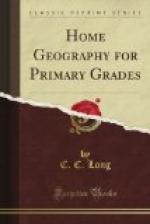When vapor rises high in the cool air it is turned into very small drops of water or minute crystals of ice, and we can see it floating about in the air. It is then called a cloud. Almost any clear day you may see clouds form and then seem to melt away.
You have seen on a blue sky, light, fleecy feather-clouds. They are very high up, and it is very cold where they are. You have also noticed the clouds at sunset with their beautiful colors. As the sun sank lower and lower, how did they change, in shape and color?
When clouds are low down, near the earth, we call them fogs or mist.
If clouds are cooled, the little particles of water gather into large drops and fall as rain. If the drops should freeze in falling, we would call them hail.
What shape are the raindrops? Of what use is the rain?
[Illustration: “HAVE YOU EVER SEEN SNOWFLAKES THROUGH A MICROSCOPE?”]
Sometimes, when it is very cold, the moisture in the air freezes before it forms into drops, and falls in the beautiful flakes we call snow. Have you ever seen snowflakes through a microscope?
Snow keeps the roots of plants warm. Many plants would die in winter if it were not for the snow. What other uses has snow?
Observe the clouds; fog, rain, snow, dew, frost, and tell what you have noticed.
Write what you have seen or noticed about vapor, clouds, rain, etc.
LESSON XVII.
THE FAIRY ARTIST.
Oh, there is a little artist
Who paints in the cold night
hours
Pictures for little children
Of wondrous trees and flowers!
Pictures of snow-white mountains
Touching the snow-white sky;
Pictures of distant oceans
Where pretty ships sail by.
Pictures of rushing rivers
By fairy bridges spanned;
Bits of beautiful landscape
Copied from elfin land.
The moon is the lamp he paints by;
His canvas the window pane;
His brush is a frozen snowflake;
Jack Frost the artist’s
name.
LESSON XVIII.
HOW RIVERS ARE MADE.
Have you ever seen a brook or creek? A river? Is there a brook or river near here? Who can tell where it begins? where the water conies from that fills it? where it goes? Let us try to understand this.
As vapor rises into high, cool air, or is carried with the air in winds up the sides of mountains, it turns into water again, and comes falling down as rain.
Now think where the rain that falls on mountains must go. Some of the water runs off on the surface, down the mountain slope. Some sinks into the ground, and runs along in little streams below the surface. It will appear again, bubbling out of the mountain side as a spring. The spring is the beginning of a river.




